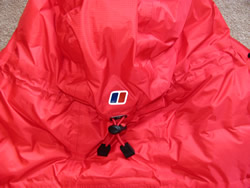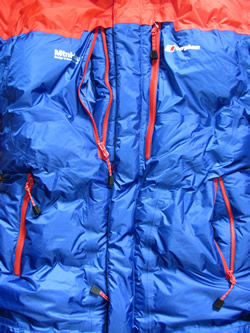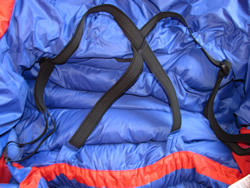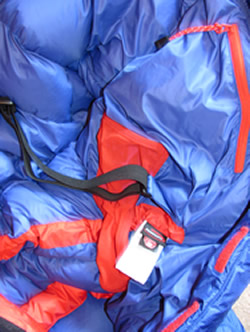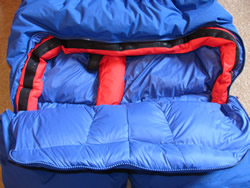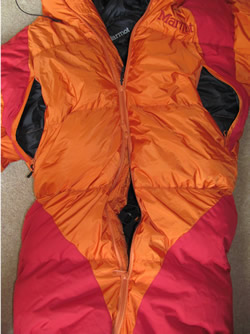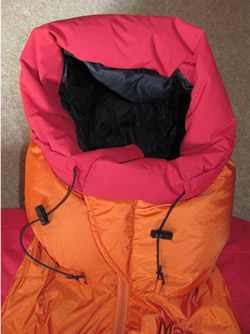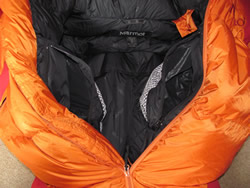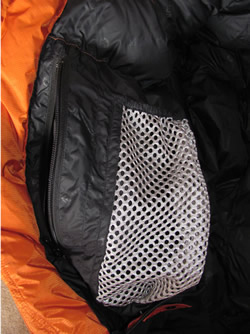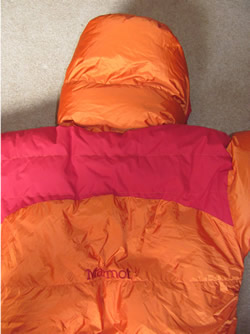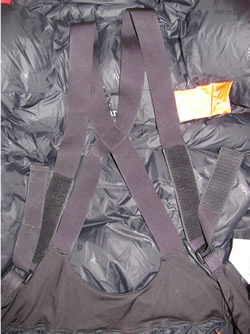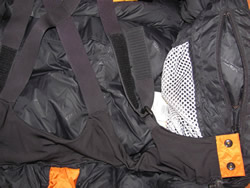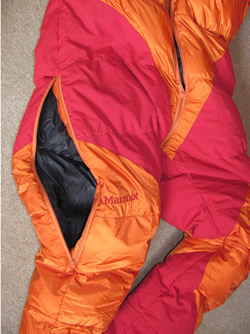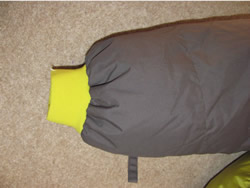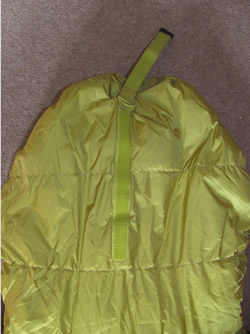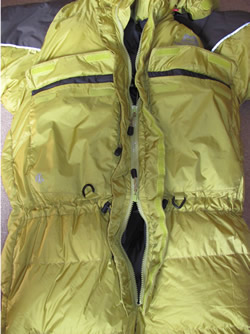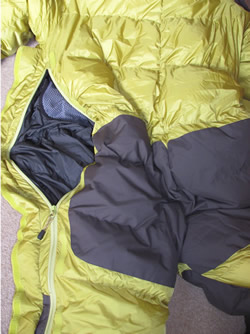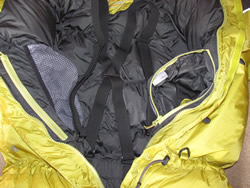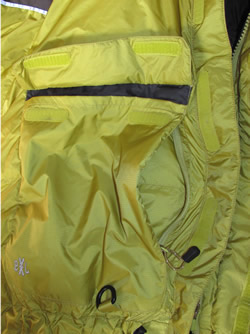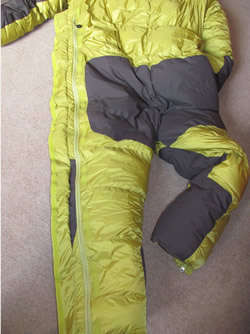Not All Down Suits Are Equal
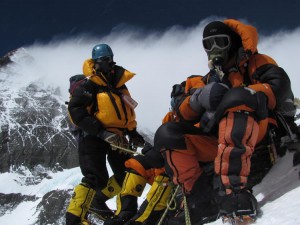
Once upon a time down suits didn’t exist and now they are considered an essential piece of clothing in the high altitude wardrobe. Don Whillans and Pete Hutchinson designed and tested the first suits way back in the 50s – Don, a plumber by trade, wanted a boiler suit full of feathers and Pete, who used to make his own gear, was the man who knew how to make it. In the great scheme of things, the concept hasn’t changed a great deal since. Materials have become lighter, down warmer, features more functional – but it is still essentially a two layer boiler suit stuffed with feathers.
When you are venturing to the coldest extreme environments of the highest altitudes or the lowest latitudes then a down suit, or a down jacket and down salopette combination, is absolutely essential. Suits are not quite as versatile as the jacket / salopettes combination but the single suit weighs less than the combined items and takes up less space. If you envisage always needing to be togged up then you may well want to have a suit, whereas if you envisage sometimes wanting the benefit of a jacket, whilst not necessarily needing the warmth of the salopettes, then the combination may be the choice. It goes without saying that if you are looking at a jacket / salopettes combination, that there needs to be a decent overlap to prevent a draught or any cold spots.
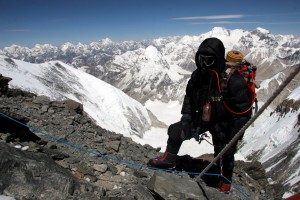
Stuart Holmes Lakespanorama.co.uk
These suits are so specialised, and shops tend to only stock one or two brands, that there isn’t anywhere that you can go and try on all of them. To that end you, the consumer, are being given the choice of the two suits that are in store which I believe is called a False Dilemma (Hobson’s Choice is when there is one option, a False Dilemma is when you are given only two options when in actual fact others also exist). If this is your first purchase, and the shop staff don’t have any altitude experience for you to call upon, then you won’t know what questions to ask or, indeed, whether the answers are relevant.
When you bear in mind that you are wearing this gear to enable you to live, move and function in a pretty harsh environment then they have got to live up to the highest standards. Yes you want to be warm, but your gear has to be functional and usable whilst in windy, frozen, icy conditions and you need to be able to operate toggles and zippers and access pockets without having to remove your gloves or mitts.
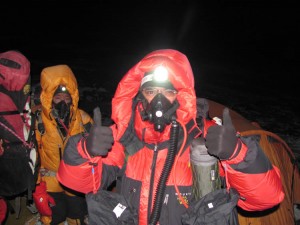
To that end make sure that you try every zipper, pocket and feature with your mitts on in the shop because it’s a bit late to discover drawbacks when you are on the mountain. You also need to remember to think about what you will be wearing under and over your suit when you try it on – and then think about how you are going to go to the toilet. There is a very subtle difference between the 3 toileting options which are a rainbow drop seat, an up and under zipper or pulling the thigh opening across. When you bear in mind that you may well be wearing a harness at the time, you will soon realise that the thigh opening choice is nowhere near as versatile as the other 2 options.
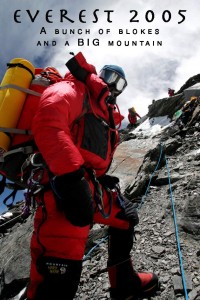
© Stuart Holmes Lakespanorama.co.uk
I’d suggest popping a helmet on and cinching the hood and then see how easily it is to adjust for when you won’t be wearing the helmet because there may be days when you need one and days when you don’t and you want to be able to adjust from one to the other as easily as possible.
Then check compatibility with how you will be wearing your mitts and your huge boots – are you a mitt over the cuff or a mitts inside the sleeve type of person? If you are thinking of having your mitts over the suit are they big enough to accommodate this as an option and still leave the down in the forearm lofted, or will your mitts compress the forearm compromising the warmth of the down (and therefore the warmth of your hand)? If you get a cold hand then, with vaso constriction at the wrist and compromised circulation due to lack of oxygen, you will struggle to reinvigorate the circulation and you may well just end up insulating a cold hand. The answer is to not get a cold hand in the first place which takes us back to whether you are going to put your mitt under or over the sleeve. You will feel little, if any, difference in the comfort of a shop or your own living room, but at ultra high altitude it is a bit late to be finding things like this out. So you may need to consider whether you want a velcro cuff or not, or what type of mitt goes with your suit.
Likewise do you envisage wearing the boot gaiters over the lower leg of the suit or underneath? Some boot gaiters are quite low volume and may compress the down, potentially leading to a cold foot, whereas if you wear your boot gaiter under the suit you need to be very careful not to end up sticking your crampons in to the suit and loosing precious down. All the suits feature crampon reinforcement patches but best to avoid sticking your crampons in there in the first place. Therefore, depending on your boots and your preference it may be important to consider whether there is a zipper on the lower leg of the suit or not.
What to look for as standard:
It goes without saying that all the suits tested are warm and they are filled with high quality down. They weren’t tested in cold conditions because I wouldn’t have a frame of reference from one suit to another. These suits were looked at with a view to their features and their function and how I envisage they will perform and work, or not, at ultra high altitude. When you bear in mind that hypoxia may be evident, which may impair your brain function and logical processes, I am a stickler for things that work intuitively and are just sensible design. Stuff that works. You shouldn’t have to start thinking about what has changed, and therefore what you need to do differently. For instance, when you don your harness you should still be able to vent zippers and, if necessary, go for a crap. When you have your mitts on you should still be able to operate the zippers and one handed operation should be the default setting. So here are a few things that you need to look for:
Fit
The suit needs to be a good fit without compressing the down – any tight areas will cause cold spots which defeats the object of spending £££s on all those feathers.
Suits now come with internal braces as standard which improves the fit and means that the top can be stripped off and worn wrapped around the waist when you are too hot. The internal braces should be detachable from their front attachment loops so that, if you have inadvertently step through one of the straps and only discover this as you are pulling the top up, then you don’t have to strip right back down again.
It sounds like a simple process, but if you have pulled on the bottom half of your suit and fitted your boots then, if you discover that you have stepped through the braces (and they are not removable) then you have just set yourself back as much as 20 minutes (yes, it does take that long). This could mean that other people are ready and waiting for you, wasting their precious oxygen and getting cold. It will undoubtedly mean that you are an inconvenience to the others in the tent and, psychologically, it will have you in a tizz and annoyed at yourself, which is not the right frame of mind for you to be in. Two of the suits featured non releasable suspenders and I sincerely hope that they rectify this issue (because it is an issue). If their answer is that you shouldn’t step through them in the first place then they clearly have not tried getting in to their suit in a dark tent, intermittently wearing oxygen and sharing with other folk who are also getting ready. Removable braces should be the default setting.
Hood
A detachable hood or a fixed hood? Personally I’ve never come across a situation where I really wish I’d been able to take the hood off my suit. Indeed I’d be concerned that if it is detachable that it could start to come undone in the windiest conditions – particularly if it hadn’t quite been poppered / velcroed / zipped back on fully. I’d also be concerned that it may be lost at some point during all the packing, unpacking and repacking that tends to go with expeditions. What you definitely need, though, is an easily adjustable hood to accommodate a helmet when wearing one or that can be cinched down when not. It also needs to be easy to adjust and not leave long tails of elastic flying around and popping you in the face.
Pockets
You need a decent number of internal and external pockets – enough so that once you set off on summit day you probably won’t be reaching in to your rucksack (which is harder than it sounds when you are all togged up and attached to your oxygen supply). So snacks, water, spare glasses, (non freezing) sun cream, camera etc all need to be stowed and accessible. You can’t have too many pockets but some pockets work better than others.
Steer clear of big Velcro outer pockets because in windy cold conditions the Velcro gets iced up, doesn’t work and before you know it your pocket is open. If that is a chest pocket then it’s only a matter of time before you’ll be dropping your precious cargo. I’m a definite fan of outer pockets of the ‘hand warmer’ variety rather than the ‘Napoleon’ variety. Actually I’d like to have both options so that I can store plenty of gear but if I only had one option or the other then the hand warmer is the one for me.
Outer pockets mean you don’t have to open the front of your suit and lose precious warmth whereas internal pockets are good for keeping things warm that need to be protected from the cold. The only thing(s) that you are going to have inside your suit are things that need protecting from the cold are a couple of ½ litre water bottles, a camera, a small tube of non freezing sun cream and a radio if you’ve got one. Some of these items (camera for instance) can go on a cord over the head and be dropped in to the front of your jacket whereas others (water bottles) definitely need to be in a pocket.
Mesh internal pockets can get trashed very quickly by Velcro (on the wrist when you are in and out of the front of the suit for instance) and also gets caught on Velcro along the zip baffle when the front is unzipped – which is just a hassle. That’s all small stuff, but it just makes for more stuff that you have to consider when you are busy enough already.
High volume internal pockets are a bit frustrating. Yes I advocate plenty of storage, but in reality the internal pockets are probably only going to be for some water so narrow, material pockets are better suited to keeping ½ litre Nalgenes vertical – so that if you haven’t quite screwed the top on properly you won’t have an inadvertent leak.
Adjustability and versatility
Ideally all the toggles on the drawcords should be one handed adjustment so that they can be tightened up, or loosened off, on the move with a single pull or a single pinch. Yes, it is easy enough to use both hands (in the comfort of a shop) but surely the default situation should be that single handed adjustment is possible because using both hands isn’t always convenient.
When you are in a situation where hypoxia can drastically impair brain function and the ability to understand logical situations, everything on the suit needs to be made as easy to use as possible. There shouldn’t be any need to have to think through the fact that putting on a harness, for instance, means that something has to then be done differently (i.e. zippers no longer slide freely and have to be fiddled with and pushed through or under gaps). This wastes precious seconds which, in an ever changing environment, compromises safety.
The other area of adjustability is the ability to vent the suit when you are too warm otherwise dehydration prevails. Some suits vent better than others. Why install a 1, 2 or 3 pull zipper when a 5 or 6 pull zipper gives far more access and venting options? For most of the suits lack of ventability was their biggest drawback. It can go from -30 to +30 in a matter of minutes in The Western Cwm and if you get caught out on The Lhotse Face, panting your way up or down the ropes, then the ability to go from super warm option to suitably vented option will be a definite bonus. It will also be much more beneficial in the long run as well. A little bit of dehydration on a daily basis means that towards the end of the trip, just when you are going for the summit bid and want to be in tip top condition, your performance will be impaired. So not overheating is almost as important as keeping warm.
Toilet access
Some suits feature a rainbow or drop seat for toilet access and others have a vertical zipper that undoes all the way round to the coccyx. It’s for you to decide which is your favoured method. One of the suits had neither! This relied on opening the thigh zipper and pulling the material across to then allow access. But when you are then trying to extricate yourself from your longjohns the opening keeps shutting and will be a regular pain in the butt (no pun intended). Add a harness and you have a situation where you are not going to be toileting very easily at all. Don’t necessarily replicate the whole procedure in the shop but at least go through the motions (so to speak) of how you are going to manage when you are on the mountain.
Other features
Reflective trim is not absolutely necessary, but is a bonus if provided. Reinforced patches at shoulders, bum, knees and ankle will add a little bit of weight but will mean that your gear will last that bit longer. Taped seams, Velcro cuffs, Velcro patches for logos from sponsors, mitt attachment points etc are all other features that you may want to take in to account, depending on your personal preferences.

The suits
The Montane APEX 8000 is the latest addition to the market. It’s a 2 piece combo and is reviewed on a separate page.
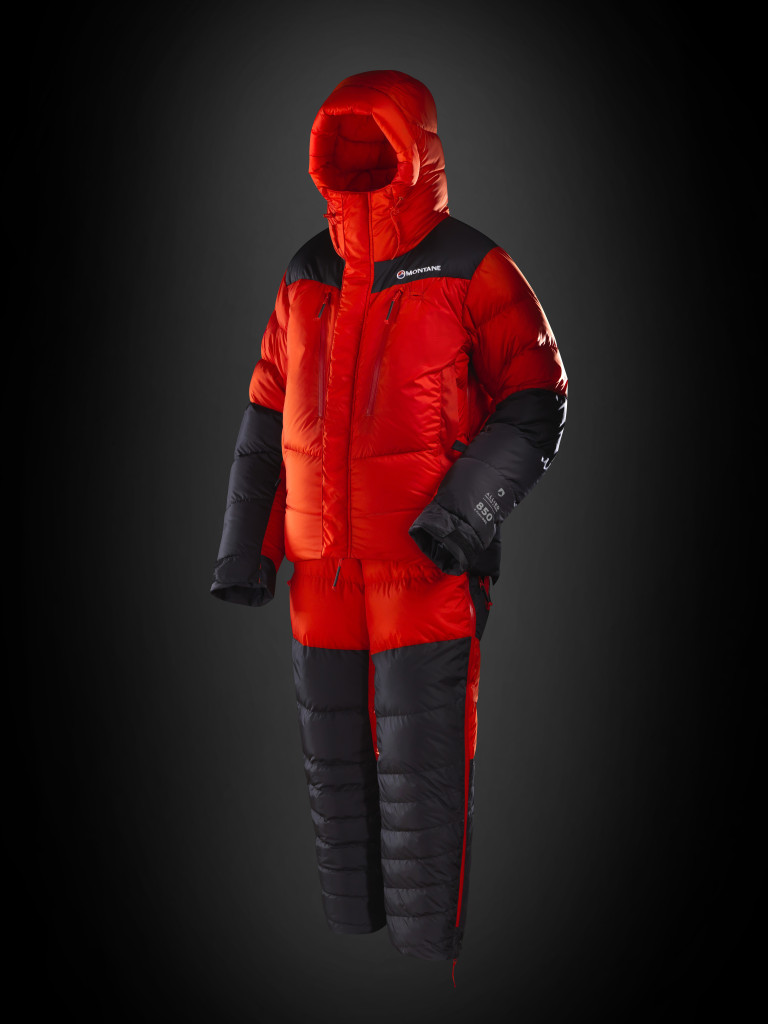
PHD Double Suit – 1,300g (-35°C / -31°F) – rrp £1,014 … or 1,465g (-50°C / -58°F) – rrp £1,199
When I received an e mail stating that PH Designs had ‘revolutionised the down suit’ I must admit that I was somewhat sceptical. What aspects of a suit filled with feathers was there to revolutionise? But when I received the goods I have to say I was pleasantly surprised. Firstly the package seemed to be almost too light – under 1.5kg making it the lightest down suit by a long chalk. But the next surprise was that the contents consisted of 3 items and therein lies the basis to their claim.
Rather than a traditional one-piece suit, or a salopettes and jacket combo, PH Designs have come up with the concept where all 3 are used in various combinations. There’s a super light one-piece suit which can be worn on its own when you are lower down the mountain, or moving in warmer conditions, and there’s a pair of overtrousers and a jacket that can be added as and when the conditions dictate. Basically it’s a modular approach and certainly quantifies their revolutionary claim.
The inner suit is made from super light material filled with super quality down, has 2 outer pockets and 2 elasticated ‘twin pockets’ inside for 4 x 1/2 litre Nalgenes, features pit zips, a removable hood, 2 way front zipper and has the option of either a rainbow drop seat or an ‘up and under’ if that is your preference and is good down to -10°C.
The inner suit is really light and doesn’t take up much space in your sac when you need to be carrying it rather than wearing it. Indeed all 3 items together not only weigh much less than any of the other suits or combos but they also take up much less space. And because there are 3 individual items they’re much easier to pack in to the spaces in your rucksack when you are ferrying gear up the hill to stash for later use.
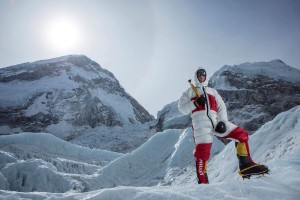
If you are buying a suit for the first time it’s all too easy to concentrate on how warm it needs to be but actually you end up wearing a suit in a whole variety of conditions and quite often you actually want a suit that isn’t too warm and allows you to be cool enough. With the 3 piece I found that I was able to keep cooler, particularly in windy conditions, than I would normally have been able to in a suit. With other suits and combos you might be able to vent off (or not depending on the make and model) by undoing various zippers … but if it’s really windy this has the negative impact of allowing unwanted spindrift in. But because this inner suit is much lighter and cooler than a full blown suit I was able to wear it in a bigger range of conditions whilst keeping pleasantly cool.
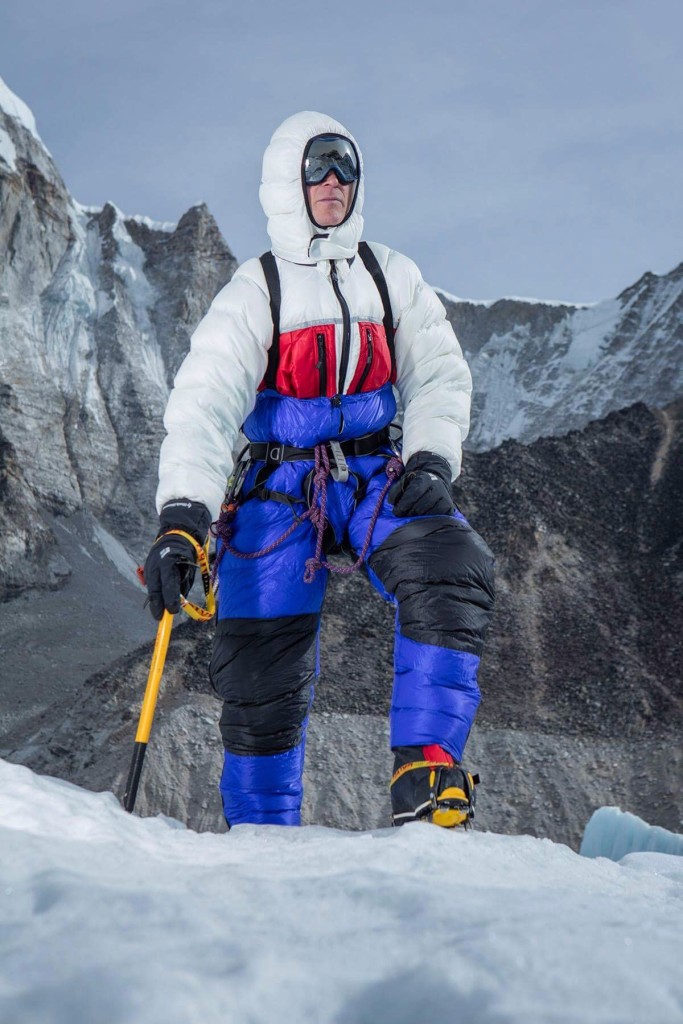
The over trousers are designed to go on over your harness and, as such, have an access hole for your cowstails to poke through. The full length zipper allows for them to be donned or removed without the need to remove crampons and everything is held in place by the ultra light removable braces which feature enough velcro on them to adjust to pretty much any height.
The over jacket is designed with the inner suit in mind … so there is a ‘through’ pocket to allow access to your inner suit pockets for your 1/2 litre water bottles or other items and the pit zips are designed in such a way that you can still operate the inner ones as easily as if you didn’t have the outer jacket on.
Importantly the ‘over’ items are cut to allow the inner suit to still function – if they were too tight you’d compress the down in the inner suit and lose the loft and warmth.
One thing that I think makes this stand out head and shoulders above the rest is that they are pretty much made to measure. For instance if you find that other medium sized suits have arms that are too short but when you wear a large then the suit is too voluminous well just tell these guys your measurements and you’ll have a suit designed that fits you without the compromise.
Another aspect that particularly impressed me is that when I got back from Everest and was giving feedback Peter Ellitot took the effort to come and visit me at home and we chatted through everything over a cup of tea and a biscuit. We discussed my findings, compared them with the feedback from others, notes were duly noted and things were taken on board for the next suits that go out of the warehouse. This wouldn’t normally be the case – with other manufacturers suits are designed and no changes are possible for a year or so as they have made their forward order. With PH Designs each and every item is made there and then in the factory by the seamstresses and are made to order. So if you want extra warmth, a longer body, shorter legs, Velcro™ patches, Napoleon pockets instead of ‘handwarmer’ pockets etc etc then it’s all possible.
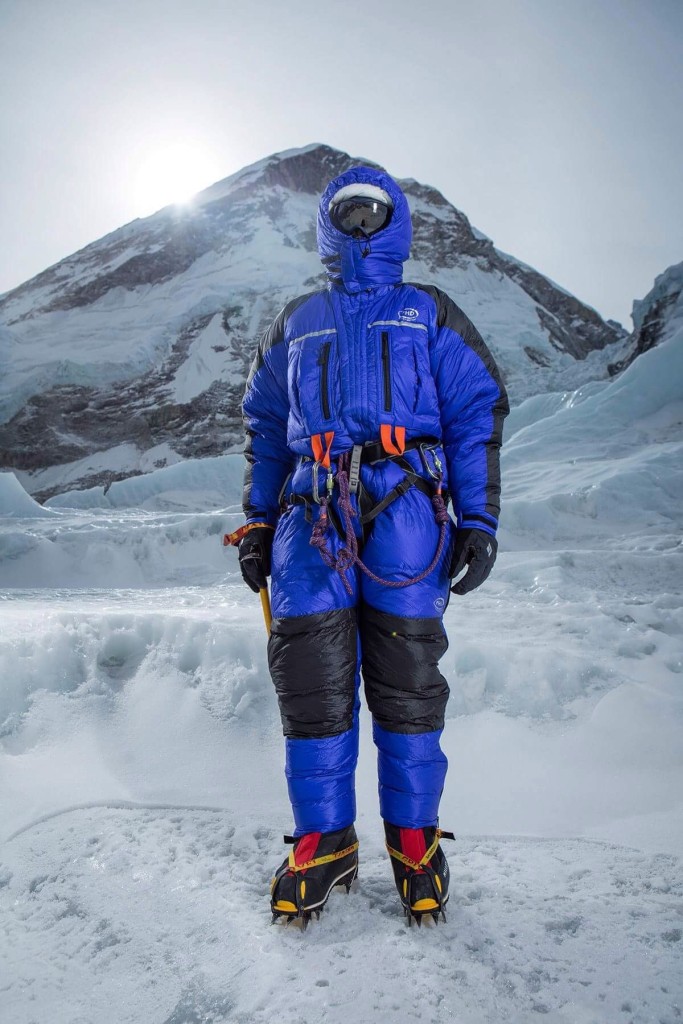
Verdict
For a suit that is literally made to measure and is totally fit for purpose then look no further. It’s the most expensive option but you get exceptional value for money and it’s more versatile than the other suits available.
9.25 / 10
Rab Expedition Suit – 1,600g – rrp £950 (up from £675)
Of all the suits tested this is the only one that I could vent off enough to allow me to sit comfortably in my office! Which, in turn, means that you are going to be able to cool down when the sun comes up in The Western Cwm or on The Lhotse Face. The leg zipper goes all the way up the torso, under the armpit to the wrist and the 5 way zipper allows for plenty of venting options. When this suit is fully togged up it is as warm as the others but it is so much more ventable – which for me means it’s much more versatile and comfortable on the mountain.
There’s a 3 way front zipper of the ‘up and under’ variety to allow for toilet (pooh) access and allows for a bit of venting. Personally I’m a rainbow drop seat man but this one works nearly as well.
It features 6 outer pockets – 4 zippered pockets on the chest (2 ‘Napoleon’ style and 2 hand warmer style) and 2 pockets with Velcro opening on the thigh (but with restricted opening to avoid inadvertent dropability).
The internal mesh pockets are zippered for extra security and are quite large. I can see this as both an advantage and a disadvantage. Yes you can get plenty of things in there but water bottles will be prone to falling over and, if the lid hasn’t quite been done up properly, a leak could ensue. With the external pockets also being quite voluminous I’d go for lower volume internal ones that keep a ½l Nalgene snugly in place.
It doesn’t feature an external baffle as a zip protector. The internal baffle works very well and sits nicely in place, but far better to have a belt and braces approach and keep the wind out in the first place. The other drawback about not having a front baffle protecting the zipper is that all the condensation that drips from the front of an oxygen mask starts to freeze the zip so it will be stuck closed. I personally advocate that zippers should be undone and done up (if closed) and done up and then undone (if the suit is open) every 15 minutes anyway, to make sure that this doesn’t become a problem. It is a potential problem with all suits when they are opened because even those with a zip baffle will then have the teeth exposed and they’ll get iced up – but it is also a problem with the Rab when zipped. This is quite a serious issue and could render a suit worse than useless in the wrong conditions.
The internal collar can be adjusted to give a very snug fit which means no nasty draughts coming in through the largest opening – the front of the hood. The chin baffle is a good feature but a bit fiddly. The wired hood to keep out the worst of the elements was another well thought out feature and the hood adjustability was great with no loose toggles flying around.
The suit doesn’t have glove attachment points – not that I’m a fan anyway as I use the idiot loop instead. A bit of a fiddly chin guard. ‘Up and under’ style toilet access. The The internal mesh pockets are zipped. Internal braces that work and are adjustable 4 excellent roomy exterior pockets The 5 zipped side zipper goes from An excellent neck toggle allows for Verdict This was the best in the test … until the price went up. See below for the latest update on the Mountain Hardwear suit and above for the latest PhD suit. It is not without its drawbacks but it has superb ventilation and loads of external pockets which means that you can be self sufficient for snacks, water and spares whilst remaining comfortable on the go, even in changeable conditions. If it is given a baffle and better internal pockets it will be almost unbeatable. 8.5 / 10 Mountain Hardwear Absolute Zero Expedition Suit – 1,800g – rrp £800 (down from £1,000) As with the Rab and TNF suits this impressed straight out of the box. As on the TNF suit this one features integrated hobo mitts which are fixed back from the wrist to allow for the sleeve to still go over down mitts. They let themselves down by not having a Velcro adjustable wrist though, having gone for the elasticated option instead. My gripe with this is that you are then forced in to either putting your mitt over the sleeve and maybe compressing the down in the suit, or if you have a snuggish low volume mitt that won’t go over you will need to put it up the inside the sleeve where the mitt may get squeezed by the cuff. Either way this could lead to you compromising the warmth of your lower arm and, in turn, your hand. Get a bigger mitt I hear you say – but then you might not be able to get your hand in to the jumar and you’ll lose dexterity for using karabiners, operating zips putting on crampons etc. Velcro I say. It’s difficult enough as it is without losing extra dexterity. A slightly oversized wrist, with a Velcro tab means I can decide according to my suit / mitt combination. It’s a small point but the addition of Velcro gives far greater versatility at little, if any, extra manufacturing cost. There are reinforced panels are on the forearm, bum, knee and inner calf and it features welded watertight baffles throughout. This suit features a 6 zipper rainbow drop seat which is zipped all the way from the ankle so not only is it great for toilet access but also for venting off in warmer conditions. As with the Rab suit this is very ventable and I could almost wear it in comfort in the office – not quite as good because the Rab venting goes all the way under the shoulder to the sleeve. The front zipper has a 4 way pull and, as with all their zippers, they are using a fine toothed reversed waterproof zipper. Thankfully the front zipper is also backed up by a single baffle to keep the frost and ice off. You do get the feeling that these zippers need to be treated with care – especially as materials start to get stiff and unmanageable in the frigid conditions. There are 2 insulated ‘Napoleon’ style pockets on the chest and an uninsulated zippered thigh pocket. Pockets in the hand warmer position would be much better – they are then more multifunctional for when you may be standing around having a chat and want to keep your hands warm. The hood adjustment does the hood and the volume all in one by way of an elasticated pull through a fixed toggle on the back of the hood – which worked surprisingly well. The orange Velcro on the braces is a great feature making them easy to find. With a bit of extra attention to the top of the front zipper / face guard area (which, whilst roomy enough to accommodate a mask, was far too voluminous without one) this will be a great suit. With hand warmer pockets instead of ‘Napoleon’ pockets it will be an awesome suit (let’s face it they both do the job of being pockets but the hand warmer position is more user friendly). With slightly longer zip pulls on some of the zippers this will be even better and competing very favourably for the No1 spot (yes, I could easily change them myself but, at a whopping £1,000, why should I have to?) A great thumb loop and cuff along but 4 way front zipper and thigh pocket. Well positioned internal pockets. Just the right size for vertical water bottles. The 6 way zipper allows for plenty of Excellent highly visible internal braces Excellent hood adjustment that changes A great hood but the chin flap is too big And the rainbow drop seat is excellent Verdict A very, very good suit. A great robust feel and a lot of attention to detail. Can be improved. The down side is the cost – but this may be rectified soon so watch this space (and as a result I have upgraded from an 8 to and 8.5 to draw equal first place with the Rab suit). This is the Dyson™ (1st generation) of down suits. Let’s hope they go for a Mk2 version and bring the cost down for the No1 spot. Update – well the cost has come down from £1,000 to £800 and so this is categorically the best value suit on the market. Note that it is not the cheapest …. but don’t be swayed by cost otherwise you will find yourself compromised on the mountain. This is the best suit when you combine value for money and key features that you ought to have when your life depends on an item of clothing in a life and death situation. 9 / 10 PHD Xero Down Suit – 1,700g – rrp £783 (up from £725) Of all the manufacturers, PHD are the only ones who make bespoke suits. They don’t sell them in retail outlets so you can’t try before you buy but they compensate for this by having a website that allows you to decide what features you would like. So you can choose a rainbow drop seat or an up and under or a side opening according to your preference. Their website also features handy notes about some of the pros and cons to help you with your choice. Without a doubt they have put a lot of thought in to their products and can react immediately to any design alterations (for instance when I mentioned about not having black braces inside a black suit I was told that, from now on, they will be putting some reflective tape in there). So whilst there is no ‘standard’ suit what I can say is that the suit I saw was incredibly well made and packed with features. The front zipper is protected by a double baffle to keep the elements at bay and protects the zip from frosting and icing. They also feature a zipped fly, slightly to one side of the main zipper, to allow easy access when you have to pee or use a sheewee without opening the whole suit and losing all that warm air which is a very good design. All the zippers have oversized zip pulls for ease of use with mitts on. There are 4 outer pockets but I’m afraid that, like the Mountain Equipment jacket (see below), the 2 pockets with simple Velcro fastening on the chest really cause me concern. The other outer pockets were hand warmer style and nicely positioned to be accessible when wearing a rucksack, or harness, or both. If you too are not a fan of Velcro outer pockets then they will easily change their design according to your preferences – at an additional cost. The internal pockets were situated nice and high to avoid bottles dropping down within the suit and meant that access involved not too much unzipping of the front to get access. It featured Velcro cuffs to allow the sleeve to go over mitts or for the wrist to be cinched and go inside them. Another nice feature which gives an edge is the use of reflector tape. There’s not a huge imposing amount of it but this stuff is so highly reflective that in an emergency situation, or a night search scenario, the wearer will stand a far better chance of being discovered. Not a situation you’d want to find yourself in but then at least in this suit you’re more likely to be getting help. There are options for a lighter fill, a detachable or a fixed hood, an extension flap to cover the oxygen mask, 900 fill down, Velcro patches and a choice of toilet access solutions. That’s probably why they don’t need to be selling retail. A generous and workable hood with one The Velcro access front pocket lets this Verdict Bespoke suits with a great reputation. Lots of good features 8 / 10 The North Face Himalayan Suit – 1,950g – rrp £950 (up from £900) Hard wearing material by the feel of it and quite evidently a well constructed suit. There are no seams visible and effectively this would appear to be a down suit which is then cocooned in an outer layer. As soon as you put this on one great feature is the powerstretch elasticated thumb loop / knuckle warmer (they call it a hobo mitt) at the end of each sleeve and the sleeves also feature Velcro wrist adjustment. The hobo mitt is recessed further up the sleeve to allow you to pull the cuff over your down mitts or alternatively if you decide not to utilise the hobo cuff it lives out of the way. Another great feature is access to the inside the suit from the outer pocket on the right side which allows for great versatility – so no need to be opening the front of the suit for a water bottle (and losing all that well earned warmth) when you can get it through the smaller pocket access. This opening also gives access to a vertically zipped pocket on the inside left of the suit. One thing I found to be a big potential drawback was that the internal braces are not removable. I don’t mean that in the sense that I might want to take them off entirely but what it does mean is that if you step through the braces whilst getting ready in your tent at night you have to remove most of the suit to rectify the problem – which isn’t versatile. As mentioned previously, if you’ve already popped your boots on then it is a veritable catastrophe which, with all that breathlessness at altitude, could set you back 20 minutes. There’s a 4 way zipper at front giving plenty of ventilation options as well as that all important pee access, and the front zipper is protected by two overlapping insulated baffles. Inside the front, a storm baffle tucks nicely behind the zipper keeping breezes out and there’s an easy to use rainbow zipper / drop pouch for toilet access. There’s a 2 way zipper on leg would allowing for ventilation options of the thigh area but it would be slightly better if it went a tad higher and had a 3 or, even better, 4 way zipper. The clip fastener at the top of the front zip is a bit fiddly with mitts on and I can’t help but feel that a side press toggle instead of middle press clip would be so much better. There are only 3 internal and 2 external pockets which really lets this fantastic suit down. A great thumb loop and cuff along with Only 2 external pockets. But access The hood is a very good fit and easy There are 2 internal pockets for water Internal braces aren’t removable There’s a 4 way zipper on the front which is protected by a double baffle. Thigh venting and the rainbow drop seat The buckle for keeping the hood closed Verdict Expensive but well thought out in most respects (hobo mitts, access to the inside though the outer pocket) but not all aspects (non removable internal braces – what is the point?). More pockets & better side ventilation would be better. If they sort the braces and it will be pegging 1st equal. 8 / 10 Berghaus Ulvetanna Hydrodown Suit – 2,150g – rrp £850 Developed in conjunction with Leo Houlding and a few others in Greenland this is certainly a very good first effort. With the use of a bit of technology and a thermal imaging camera the team were able to compare and contrast various suits and find out where on the body we would benefit having the most warmth. Using this information they have studiously mapped out which areas need the greatest amount of down and which areas can cope with less. They call it their 3 zone body mapping and have created areas with high fill down (torso, wrapping around the kidneys, tops of the arms and the thighs), medium fill (head, shoulders, arms below the biceps, most of the back, back of the legs and the shins) and low fill (arm pits, inner forearms, inner legs). I guess the idea here is that you might still have roughly the same amount of down as another suit except it is thicker where you need it most and thinner where it is virtually redundant. Having said that this is quite a heavy suit and comes in a couple of hundred gms heavier than most of the others. The suit is filled with HydroDown™ which is down that has been treated to repel moisture and keep you drier and warmer. It apparently dries quicker when wet and recovers its loft faster than regular down too. They also use waterproof fabric panels in damage prone areas. There are oodles of pockets which is a great feature, however not all of them are great. There are 2 on the thighs (good), 2 insulated Napoleon pockets (good), an inner zipped pocket (good) and 2 insulated pockets at waist level that may get compromised depending on your harness (medium good to poor). But the 2 internal mesh pockets are not great at all. They are very difficult to use easily due to a combination of their location and the proximity of the braces, and if the waist draw cord is cinched they are nigh on impossible to use (and that is in my kitchen with no gloves on). Trying to get a ½l Nalgene in there whilst wearing mitts will be a definite distraction. These need to be moved. Kept. But moved. Personally I’d also say that the waist level pockets would be better suited in the hand warmer position at chest level. Similar to the Mountain Hardwear suit this also features a 6 zipper rainbow drop seat which is zipped all the way from the ankle so not only is it great for toilet access but also for venting off in warmer conditions. As with the Rab suit this is very ventable and I could almost wear it in comfort in the office – not quite as good because the Rab venting goes all the way under the shoulder to the sleeve. They use nice big chunky zips that don’t feel frail like some of the fine toothed ones and they have nice, long, easy to grasp zip pulls on them. There is a 3 way zipper at the front which is protected by an outer baffle as well as an internal baffle. The chunky leg zippers just have an internal baffle which sits really well. The internal suspenders are not removable which I think is a big potential drawback (see note about the same issue in The North Face suit above) and are made from elastic which means that you have to cinch them quite a bit to get them to hold in the right position … which makes using those internal pockets I mentioned earlier quite difficult. A wider, static webbing would almost undoubtedly be better. The front of the hood is adjusted on each side with a single pull down to tighten and a single pull sideways on a separate attachment to loosen. But on the rear of the hood they have gone for 2 separate pulls through the same spring loaded toggle. This would be much better if it was just a single piece of elastic looped through rather than having 2 separate adjusters (see the Mountain Hardwear set up). Invariably with big mitts on, and in challenging conditions, it is easier to find one thing to grab instead of 2. Having said that, the adjustment potential is very good and can easily cater for a helmet on / helmet off situation. As with the Mountain Hardwear suit and The North Face suit there is a hobo mitt located within the sleeve, which is a great feature, and this is backed up with velcro adjustment for the wrist. All in all this is another great suit to join the main 4 and, at the price, is a great contender. 2 pulls on the rear of the hood where one would suffice (& be easier to manage). The main body showing the Napoleon pockets and the waist pockets, which are difficult to access whilst wearing a harness. The thigh pockets, the 6 way leg zippers and the hobo mitt – all good features. The elasticated braces didn’t feel as comfortable as non elasticated ones. The internal mesh pockets are compromised as seen here by the location of the braces and the elasticated waist band. Useless. And the rainbow seat gives excellent toilet access. Verdict A really well thought out suit at a good price. The internal mesh pockets need a serious redesign because they are an essential part of your summit day self sufficiency and the waist pockets could perhaps be better located. The pulls on the rear of the hood would be better as a single pull instead of 2 independent ones and the braces could be better. But the 3 zone body mapping is a great feature as are the oodles of pockets for storage. 8.25 / 10 Marmot 8,000m Suit– 1,845g – rrp £800 (Please note that this review is for the older (orange and red) version of the suit. I notice that they now do a newer version but as yet I have not reviewed it). For a big brand producer with a great reputation this seems to be quite a minimalist and ill conceived suit really. I’m not sure whether that is because they haven’t put much thought in to it or whether they are adopting the less is more attitude. Whichever it is, this is not a great suit. Their blurb mentions Primaloft here and baffles there but at the end of the day, as I said earlier, all these suits are warm so differentiation has to be achieved by features that make the suit more versatile. There are only 2 outer pockets (although these were zippered, slanted hand warmer style chest pockets and readily accessible) and they have opted for 4 internal pockets. 2 of the internal ones are obviously for drinks bottles and the other 2 are zippered map pocket style pockets. So whilst they end up with the same number of pockets and amount of storage as most of the other suits you have to undo the front of the suit to get to a lot of your stuff. There’s no outer zip baffle so, as with the Rab suit, the zipper is directly exposed to the wind and will get frozen with the dripping condensation from your mask. Other than the front zip the only other ventilation is a one way thigh zipper from the hip to the knee which gets compromised as soon as a harness is worn. Toilet access is by way of the up and under front zip which has a 4 way zipper which is the only redeeming feature really. The internal suspenders are absolutely useless because there is not enough Velcro for them to be cinched high enough. You have to ask yourself how much would it cost for the fluffy bit of Velcro to be extended by about 10″. In this instance there is absolutely no reason not to have a longer strip of Velcro. To make something that doesn’t work properly – that is just poor attention to detail. I could always buy some Velcro and attach it myself … but for £800 surely, in the 21st century, this should be done by the manufacturer? On the hood there is no possibility to adjust for volume so you can’t alter from a helmet on / helmet off situation. They have gone for extra attention by having the elastic tied to a small loop on the body of the suit, but then the toggles aren’t fixed to the suit to allow one handed operation. There’s a pouch in the inside back of the suit for a hydration pack and a sleeve to hold the drinks tube in place. This wasn’t tested in a cold environment and so I can’t vouch for whether it works or not. Personally I’d shelve that in favour of better features elsewhere. Only 2 outer pockets and no outer zip baffle Elastic attached to the body of the suit (good) but the toggles are not (bad). They should allow for single handed adjustment. There are 4 internal pockets but it would be better if 2 of these were outside. Zippered and mesh internal pockets. No helmet / volume adjuster The braces that are worse than useless. There’s not enough material for them to be adjusted upwards. And I’m no midget. Braces and internal harness detail. The harness felt great but was let down by the braces. Thigh vent could be better. Verdict Not a great suit, especially at the price. Absolutely rubbish suspenders. Not worth buying as there are much better suits at around the same price or cheaper. 4 / 10 Mountain Equipment Redline Suit – 2140g (L) – No longer being made! I wonder why? But be aware that it is still available online from various retailers who still have stock. Of all the suits that I tried this is the only one that I would categorically say ‘Do Not Buy this product‘. Even though it has now been discontinued there are still some retailers who have stock … I’ll say again DO NOT BUY this suit. It is the cheapest but it is also the one with the least thought. As a first effort at a GCSE in design it is only just ok, and hopefully ME will build on this suit and bring it in to line with the others. But for the time being, steer clear. So, why is this not for me? Well there are some features that I guess are personal preference but there are others that are just bad design. Personally I wasn’t so keen on the elasticated cuffs as there isn’t the flexibility that you get with oversized cuffs and Velcro. As mentioned previously, there would not be an option, for instance, of having your down mitt inside the sleeve. The one pull adjustment for the front of the hood was very fiddly and didn’t pull through very easily. It was also difficult to locate and once cinched there’s a lot of elastic with a small toggle on the end flying around in windy conditions – a better option is to have the elastic stitched back in to a seam to prevent this problem. The volume adjuster at the back of the hood is totally useless. There is one strip of Velcro that pulls down on to another strip of Velcro which, if not quite located properly (because you can’t feel the Velcro with your mitts on folks) will end up flapping loose and coming undone. If they insist on using Velcro for the volume adjuster it should be going up and through a small buckle and then down on to the other piece of Velcro. Alternatively a one handed elasticated pull through a toggle would be much better. The waist adjustment would be better if the toggle was attached to the suit making it a one handed adjustment. This is a very simple matter for them to rectify and, as mentioned earlier, single hand adjustability should be the default option. There are 4 external pockets – 2 are zipped ‘Napoleon’ style pockets and 2 are vertical pockets with a Velcro flap which really didn’t do it for me. There’s not much Velcro and if it gets frosted up the pocket will be worse than useless. With the pocket being quite voluminous I would be very worried that items will inadvertently end up tumbling down the mountain – it’s only a matter of time so don’t say I didn’t warn you. There are 4 internal pockets (2 for water bottles and 2 zippered pockets for stowage) which, whilst providing additional storage, exacerbates the potential for the outer Velcro pocket popping open as more and more gear gets stuffed in to every crevice. There’s only a 2 way zipper on the leg. The zipper has been extended up the torso to allow for crapping but this means the gap is then too big when venting the thigh and leaves the torso completely exposed – that is if you can actually get the side opened when you are wearing a rucksack and a harness, and down mitts, which is very doubtful. It has an insulated storm flap over the front zipper. There’s also a radio mic attachment point which some may view as being useful. Personally I attach my radio handset to my rucksack but I could see that this would be handy for some people who may have a different preference. Elasticated cuff with no velcro = no versatility Very poor helmet adjustment. This is in need of a buckle for the velcro to go up and over for it to work properly. Toggles not attached to the body. They use a very chunky zip which would be better with a 3 or 4 way option but at least it has a baffle. Also you can’t vent off easily when wearing a harness. 4 internal pockets There are 4 outer pockets – 2 Velcro and 2 zippered. The Velcro pockets are not adequate. The leg zip is the only way of being able to access for toilet arrangements. This is not an easy task. Verdict – Steer clear of this suit. 2 / 10 So there you have it. A like for like comparison of the main 7 down suits (readily available in the UK) that you ever likely to consider for Everest (or any other 8,000er for that matter of fact). Like it says at the top of the page … not all down suits are equal. Do not accept that you only have the choice of the two in the shop that you visit. Quite literally your life will depend on having the best that there is and you want to make sure that it is going to not only keep you warm but also perform, be functional and versatile. So if the shop doesn’t have many in their range make sure you go elsewhere as well to get a like for like comparison. And remember, it’s only a rich man that buys a cheap suit! Stuart Holmes Lakespanorama.co.uk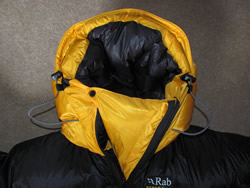
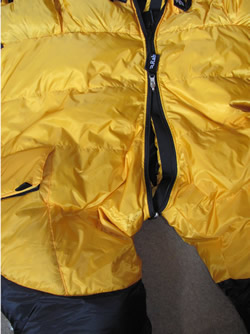
thigh pockets have Velcro access but
are backed up with stitching that
restricts access which, in turn,
prevents dropability.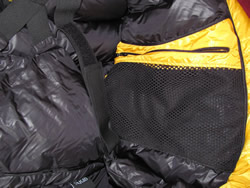
But they are almost too roomy.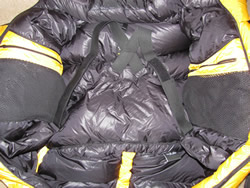
(but are a little bit difficult to find being black
in amongst all that black material).
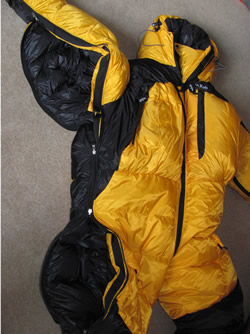
the ankle, under the armpit and
all the way to the wrist. This allows
for a great degree of ventability.
Best in the test for this.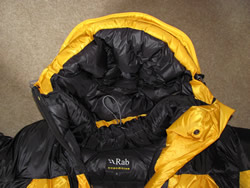
precision adjustment to keep out the
worst conditions.
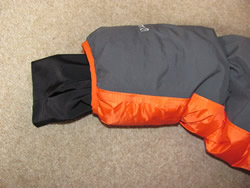
without Velcro adjuster on the wrist.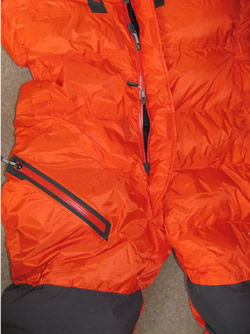
Waterproof zips feel that they need
to be treated with care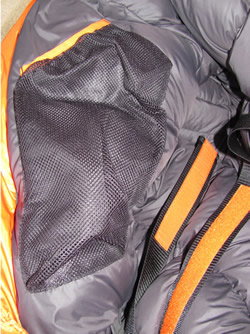
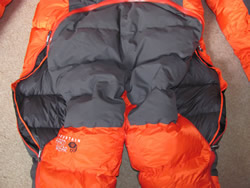
venting options on the thighs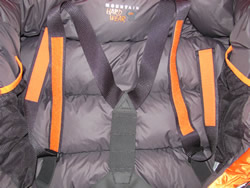
that are easy to locate.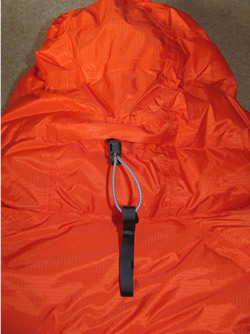
fit and volume with just one pull on
the easily accessible extension.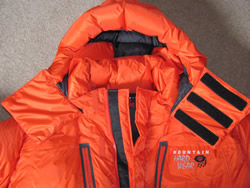
when not wearing a mask. This is not its
best feature. The chest pockets are
‘Napoleon’ style – it would be so much
better if they were in the ‘hand
warmer’ position instead.
for toilet access
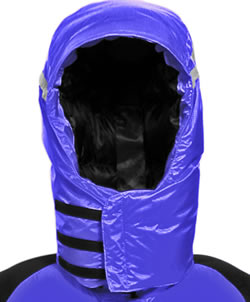
pull front adjusters and a volume adjuster
at the back. Personally I’d prefer shock
cord instead of the non elasticated cord
they use (which doesn’t pull through very
smoothly) but they reason that elastic,
being stretchy, will create more excess
which may then end up being blown
in your face.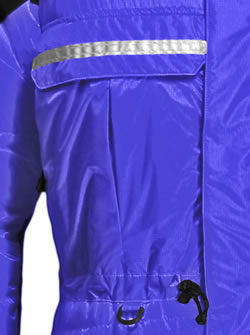
suit down. Having said that, if you said
you wanted something different then that
is what you’ll get. There is no ‘standard’
suit and they will make according to
individual requirements. The baffle on
the front zipper comes as standard.
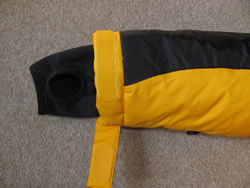
Velcro adjuster on the wrist.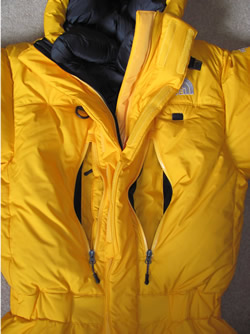
is possible through the right pocket
to the inside of the suit.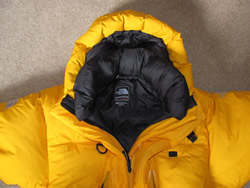
to adjust for fit and volume.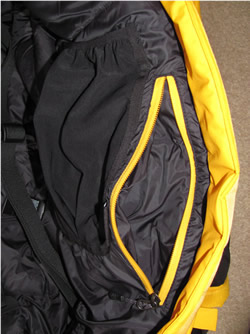
& a 3rd , zipped, pocket on the left.
which is a pain if you inadvertently
step through them.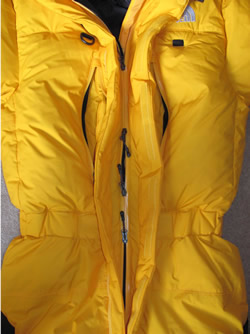
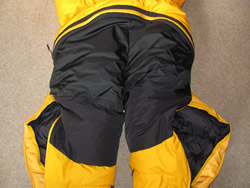
which works extremely well.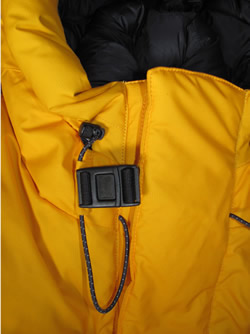
is too fiddly with down mitts on.
